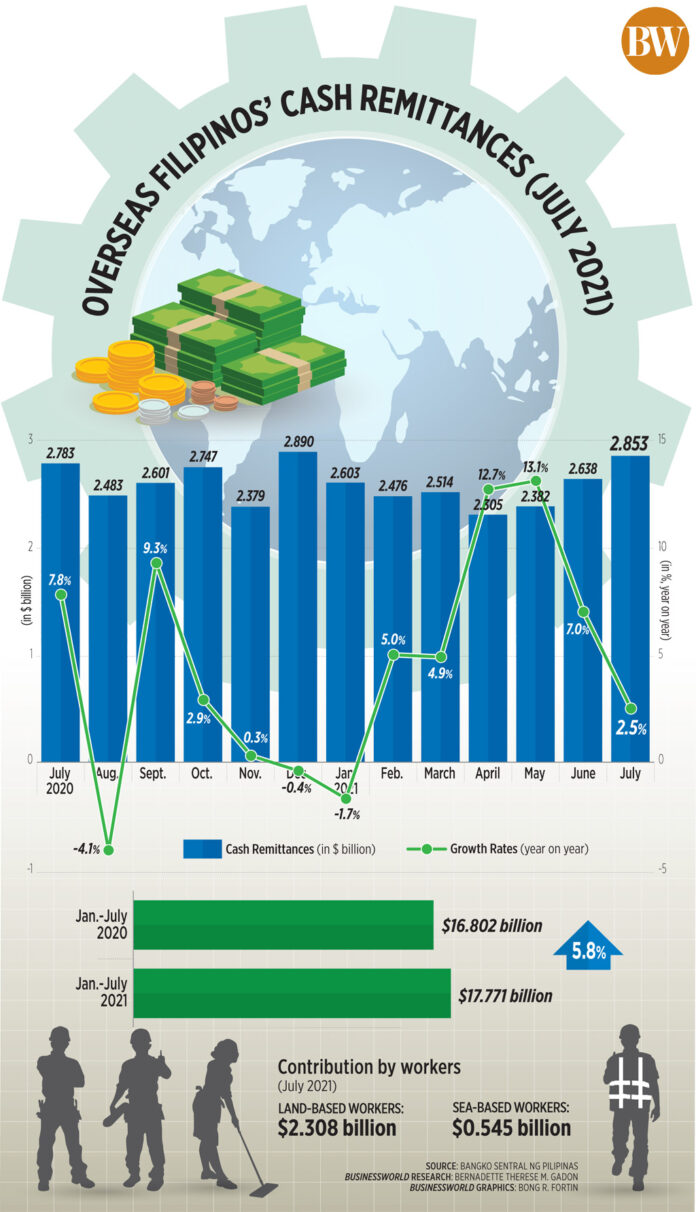By Luz Wendy T. Noble, Reporter
MONEY SENT HOME by overseas Filipino workers (OFWs) reached a seven-month high in July, reflecting the improved employment situation in major economies that have begun recovering from the coronavirus pandemic.
Cash remittances rose 2.5% to $2.853 billion in July from $2.783 billion a year earlier, based on data released by the Bangko Sentral ng Pilipinas (BSP) on Wednesday.
July remittance inflows are at the highest level since the $2.89 billion in December 2020.
Cash remittances likewise increased 8.1% from the $2.638 billion in June.
“The increase in cash remittances was due to the growth in remittances from land-based workers and sea-based workers, which rose by 1.6% (to $2.308 billion from $2.273 billion) and 6.9% (to $545 million from $510 million), respectively,” the BSP said.
For the first seven months of 2021, cash remittances stood at $17.771 billion, up 5.8% from the $16.802 billion in the same period of 2020.
The BSP said remittances from OFWs in the United States, Malaysia, and South Korea helped boost the year-to-date tally.
By countries, the US is still the biggest remittance source, followed by Singapore, Saudi Arabia, Japan, the United Kingdom, the United Arab Emirates, Canada, South Korea, Qatar, and Taiwan. Together, inflows from these countries made up 78.6% of the total for the period.
UnionBank of the Philippines, Inc. Chief Economist Ruben Carlo O. Asuncion said the remittance growth can be attributed to the improvement in the labor markets abroad as more economies reopened.
“It seems that a number of those who have been repatriated at the early part of the pandemic back in 2020 may have already returned and our OFWs are very aware of the need to send many back home probably for health support to family,” he said in an e-mail.
The “more favorable” exchange rate also helped boost remittance sent back home, alongside improving economic activities, Security Bank Corp. Chief Economist Robert Dan J. Roces said in a Viber message.
The peso has been relatively weaker versus the dollar in the previous months, moving around the P49 to P50 range. At its close of P49.97 per dollar on July 30, the peso depreciated by 94.7 centavos or by 1.9% from its 48.023 finish on Dec. 29, 2020.
Meanwhile, personal remittances, which include inflows in kind, went up 2.6% to $3.167 billion from $3.085 billion in July 2020.
Year to date, personal remittances increased 6% to $19.783 billion from $18.658 billion in the same period of 2020.
Mr. Asuncion is bullish that remittances will remain resilient ahead of the holiday season.
On the other hand, Mr. Roces said the spread of the Delta variant poses risks to the outlook as the reimposition of lockdown measures may lead to more OFWs losing their jobs.
“But remittance inflows remain crucial, especially for recipient households and to the economy, in general, as it stands to get supported via consumption,” Mr. Roces said.
Remittance inflows support household spending, which makes up about 70% of the economy.
The BSP expects cash remittances to rebound with a 4% growth this year after declining by 0.8% in 2020.

